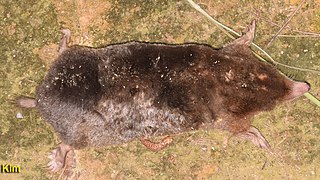
Dipodoidea is a superfamily of rodents, also known as dipodoids, found across the Northern Hemisphere. This superfamily includes over 50 species among the 16 genera in 3 families. They include the jerboas, jumping mice, and birch mice. Different species are found in grassland, deserts, and forests. They are all capable of saltation, a feature that is most highly evolved in the desert-dwelling jerboas.

The Gansu shrew is a red-toothed shrew found only in a small part of Gansu province and other adjacent areas of China. With its very limited range, it is sensitive to habitat loss and is listed as a "vulnerable species" in the Chinese Red List, while the IUCN lists it as being "data deficient"

The Ussuri shrew, also known as the giant shrew, is a species of shrew found in Northeast Asia. An adult Ussuri shrew has a total length including the tail of 137 to 170 mm. It is found in valleys and on the forested slopes of mountains in the Korean Peninsula, northeastern China, and the Russian Far East. It is rarely observed, and its ecology is largely unknown.

Birch mice are small jumping rodents that resemble mice with long, tufted tails and very long hind legs, allowing for remarkable leaps. They are the only extant members of the family Sminthidae. They are native to Eurasian forests and steppes. All variants possess a long tail of 65 to 110 mm of length and weigh about 6 to 14 g. Head and body length of 50 to 90 mm and hind foot length of 14 to 18 mm. The animal's skin color is light brown or dark-brown to brownish yellow on the upper side and paler on the underside, but generally brownish. Birch mice have a vast geographic distribution in that they inhabit a wide variety of habitats, from semiarid areas to subalpine meadows. Although they have a diverse region of areas, their molecular and anatomical markers have claimed that Birch mice originated from Central Asia.Birch mice have a systematic of the genus of Sicista, they look at the male reproductive organs and cytogenic data.

The northern birch mouse is a small rodent about 5 to 8 cm long, weighing 5 to 13 g. It lives in northern Europe and Asia in forest and marsh zones.

The southern birch mouse is a species of birch mouse in the family Sminthidae. It is native to southern Russia, Kazakhstan, and potentially northern Mongolia and China.
The long-tailed dwarf hamster is a species of rodent in the family Cricetidae. It is found in China, Kazakhstan, Mongolia, and Russia.
Mittendorf's lemniscomys or Mittendorf's striped grass mouse is a species of rodent in the family Muridae. It is endemic to Cameroon where it is found at high elevations on a single mountain. Its natural habitat is tropical high-altitude grassland. It faces no particular threats and the International Union for Conservation of Nature has listed it as being of "least concern".
The Ethiopian forest brush-furred rat or golden-footed brush-furred rat, is a species of rodent in the family Muridae. It is endemic to Ethiopia where its natural habitat is subtropical or tropical moist montane forests. It is threatened by habitat loss.

The bushy-tailed jird or bushy-tailed dipodil is a species of rodent in the family Muridae. It is the only species in the genus Sekeetamys. It is found in Egypt, Israel, Jordan, Saudi Arabia, and Sudan. Its natural habitat is rocky areas.

Hildegarde's broad-headed mouse or Hildegarde's zelotomys is a species of rodent in the family Muridae. It is found in Central Africa.
The Chinese jumping mouse is a species of rodent in the family Dipodidae. It is monotypic within the genus Eozapus. It is endemic to China where its natural habitat is temperate forests, steppes and meadows in mountainous regions. It is tolerant of some degree of habitat destruction, and the International Union for Conservation of Nature has assessed its conservation status as being of "least concern".
The Armenian birch mouse is a species of rodent in the family Sminthidae.
The Tien Shan birch mouse is a species of rodent in the family Sminthidae. It is found in China, Kazakhstan and Kyrgyzstan.

The Ussuri mole or large mole, is a species of mammal in the family Talpidae, formerly treated as a subspecies of the Japanese mole. It is found in China, North Korea, South Korea, and Russia and lives in a long burrow, seldom emerging on the surface of the ground during the day.

Sminthidae is a family of mouse-like jumping rodents. They are represented by only one extant genus, Sicista, represented by 19 species found throughout most of Eurasia, from central Europe east to Siberia, and south to southern China. However, they were much more diverse and had a much wider range in prehistoric times, having multiple genera and being found not only in Eurasia but also throughout North America, where they existed up to the early Pleistocene. They have a well-attested fossil record which dates as far back as the early Oligocene.









